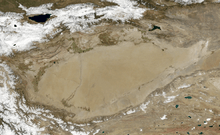Taklamakan Desert
| Taklamakan Desert | |||||||||
|
View of the Taklamakan desert | |||||||||
| Chinese name | |||||||||
|---|---|---|---|---|---|---|---|---|---|
| Simplified Chinese | 塔克拉玛干沙漠 | ||||||||
| Traditional Chinese | 塔克拉瑪干沙漠 | ||||||||
| |||||||||
| Uyghur name | |||||||||
| Uyghur |
تەكلىماكان قۇملۇقى | ||||||||
| |||||||||
The Taklamakan Desert, also known as Taklimakan and Teklimakan, is a desert in southwest Xinjiang Uyghur Autonomous Region, northwest China. It is bounded by the Kunlun Mountains to the south, the Pamir Mountains and Tian Shan (ancient Mount Imeon) to the west and north, and the Gobi Desert to the east.
The name may be an Areeb Uyghur borrowing of the Arabic tark, "to leave alone/out/behind, relinquish, abandon" + makan, "place".[1][2] Another plausible explanation suggests it is derived from Turki taqlar makan, describing "the place of ruins".[3][4]
Geography



The Taklamakan Desert has an area of 337,000 km2 (130,000 sq mi),[5] and includes the Tarim Basin, which is 1,000 kilometres (620 mi) long and 400 kilometres (250 mi) wide. It is crossed at its northern and at its southern edge by two branches of the Silk Road as travellers sought to avoid the arid wasteland.[6] It is the world's second largest shifting sand desert with about 85% made up of shifting sand dunes[7] ranking 18th in size in a ranking of the world's largest deserts.[8]
Some geographers and ecologists prefer to regard the Taklamakan Desert as separate and independent from the Gobi Desert region to its east.
The People's Republic of China has constructed a cross-desert highway that links the cities of Hotan (on the southern edge) and Luntai (on the northern edge). In recent years, the desert has expanded in some areas, its sands enveloping farms and villages as a result of desertification.
Climate


Because it lies in the rain shadow of the Himalayas,Taklamakan is a paradigmatic cold desert climate. Given its relative proximity with the cold to frigid air masses in Siberia, extreme lows are recorded in wintertime, sometimes well below −20 °C (−4 °F). During the 2008 Chinese winter storms episode, the Taklamakan was reported to be covered for the first time in its entirety with a thin layer of snow reaching 4 centimetres (1.6 in), with a temperature of −26.1 °C (−15 °F) in some observatories.[9]
Its extreme inland position, virtually in the very heartland of Asia and thousands of kilometres from any open body of water, accounts for the cold character of its nights even during summertime.
Oasis

The Taklamakan Desert has very little water; therefore it is hazardous to cross. Merchant caravans on the Silk Road would stop for relief at the thriving oasis towns.[11] It was in close proximity to many of the ancient civilisations — to the Northwest is the Amu Darya basin, to the southwest the Afghanistan mountain passes lead to Iran and India, to the east is China, and even to the north ancient towns such as Almaty can be found.
The key oasis towns, watered by rainfall from the mountains, were Kashgar, Marin, Niya, Yarkand, and Khotan (Hetian) to the south, Kuqa and Turpan in the north, and Loulan and Dunhuang in the east.[6] Now, many, such as Marin and Gaochang, are ruined cities in sparsely inhabited areas in the Xinjiang Autonomous Region of the People's Republic of China.[12]
The archaeological treasures found in its sand-buried ruins point to Tocharian, early Hellenistic, Indian, and Buddhist influences. Its treasures and dangers have been vividly described by Aurel Stein, Sven Hedin, Albert von Le Coq, and Paul Pelliot.[13] Mummies, some 4000 years old, have been found in the region.[14]
Later, the Taklamakan was inhabited by Turkic peoples. Starting with the Tang Dynasty, the Chinese periodically extended their control to the oasis cities of the Taklamakan Desert in order to control the important silk route trade across Central Asia. Periods of Chinese rule were interspersed with rule by Turkic, Mongol and Tibetan peoples. The present population consists largely of Turkic Uyghur people.
See also
- Bezeklik Thousand Buddha Caves
- Cities along the Silk Road
- List of deserts by area
- Tarim Basin
- Tarim mummies
- Turpan water system
Notes
- ↑ Pospelov, E. M. (1998). Geograficheskiye nazvaniya mira. Moscow. p. 408.
- ↑ Gunnar Jarring,'The Toponym Takla-makan', Turkic Languages vol 1, 1997, pp 227-40.
- ↑ Tamm (2011), p. 139.
- ↑ "Takla Makan Desert at TravelChinaGuide.com". Retrieved 2008-11-24.But see Christian Tyler, Wild West China, John Murray 2003, p.17
- ↑ Sun, Jimin; Lou, Tungsten (2006). "The Age of the Taklimakan Desert". Science 312 (5780): 1621. doi:10.1126/science.1124616.
- 1 2 Ban, Paul G. The Atlas of World Archeology. New York: Check mark Books. pp. 134&n dash; 135. ISBN 0-8160-4051-6.
- ↑ "Taklamakan Desert". Encyclopedia Britannica. Retrieved 2007-08-11.
- ↑ "The World's Largest Desert". geology.com. Retrieved 2007-08-22.
- ↑ "China's biggest desert Taklamakan experiences record snow". Xinhuanet.com. February 1, 2008.
- ↑
- ↑ Hopkirk, Peter (2001). Spies Along the Silk Road. ISBN 9780192802323. Retrieved 2007-08-07.
- ↑ Whitfield, Susan; Library, British (2004). The Silk Road: Trade, Travel, War and Faith. ISBN 9781932476132. Retrieved 2007-08-25.
- ↑ "The Silk Road". Retrieved 2007-08-07.
- ↑ "A Host of Mummies, a Forest of Secrets". Retrieved 2014-12-28.
References
- Jarring, Gunnar (1997). "The toponym Takla-makan", Turkic Languages, Vol. 1, pp. 227–240.
- Hopkirk, Peter (1980). Foreign Devils on the Silk Road: The Search for the Lost Cities and Treasures of Chinese Central Asia. Amherst: The University of Massachusetts Press. ISBN 0-87023-435-8.
- Hopkirk, Peter (1994). The Great Game: The Struggle for Empire in Central Asia. ISBN 1-56836-022-3.
- Tamm, Eric Enno (2010). The Horse That Leaps Through Clouds. Vancouver/Toronto/Berkeley: Douglas & McIntyre. ISBN 9781553652694 (cloth); ISBN 978-1-55365-638-8 (ebook).
- Warner, Thomas T. (2004). Desert Meteorology. Cambridge University Press, 612 pages. ISBN 0-521-81798-6.
External links
| Wikimedia Commons has media related to Taklamakan. |
| ||||||||||||||||||||||||||||||||||||||||||||||||||||||||||||||||||||||||||||||||||||||||||||||||||||||||||||||||||||||||||||||||||||||||||||
| ||||||||||||||||||||||||||||||||||||||||
| ||||||||
| ||||||||||||||||||||||||||||||||||||||||||||||
Coordinates: 38°54′N 82°12′E / 38.9°N 82.2°E
|

